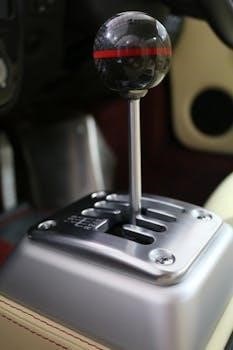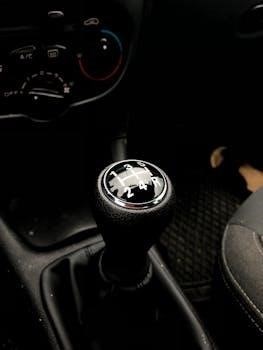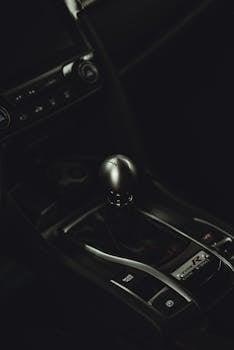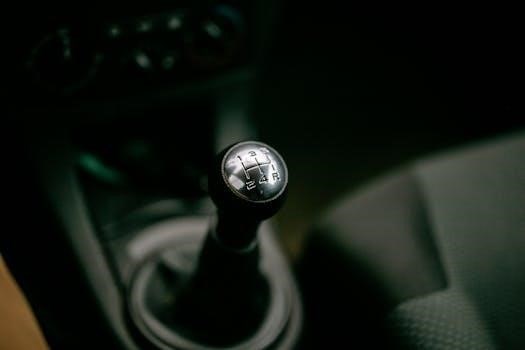E46 Manual Transmission Swap⁚ A Comprehensive Guide
Considering a manual transmission swap for your E46? This guide offers a comprehensive overview, covering everything from reasons for the swap to essential parts and step-by-step instructions. We will provide expert advice, DIY guides, and essential tips for a successful conversion.
Reasons for Considering a Manual Swap
Many E46 enthusiasts consider a manual transmission swap for various compelling reasons. A primary motivation is enhanced driving engagement. Manual transmissions offer a more direct connection to the engine, providing drivers with greater control over gear selection and overall driving experience. This can translate to a more sporty and involved feel, particularly appealing to those who enjoy spirited driving.
Another reason is improved performance. Manual transmissions generally weigh less than their automatic counterparts, contributing to better acceleration and handling. Furthermore, they often offer more efficient power transfer, potentially leading to increased fuel economy in certain driving conditions.
Durability and reliability can also be factors. Automatic transmissions, especially older ones, can be prone to issues and costly repairs. A well-maintained manual transmission can be a more robust and reliable option in the long run. Finally, some owners simply prefer the feel and control of a manual transmission, finding it more enjoyable and rewarding to drive. The possibility to customize the driving experience is also a plus.
Essential Parts List for the Swap
Embarking on an E46 manual transmission swap requires gathering a comprehensive list of essential parts. At the core of the swap is the manual transmission itself, ideally a ZF 5-speed. Accompanying the transmission is the appropriate clutch kit, flywheel, and associated hardware. The pedal box must be swapped to include the clutch pedal assembly, along with the master and slave cylinders.
A manual transmission driveshaft is crucial, ensuring proper fitment and function with the new gearbox. The transmission brace also needs to be changed for manual version. The shifter assembly, including the shift knob and linkage, is necessary for gear selection. Don’t forget the smaller but critical components like the pilot bearing, release bearing, and various bolts and seals.
For a seamless integration, consider the differential. While not always mandatory, switching to a manual transmission differential can optimize gear ratios for better performance. Finally, factor in the wiring harness modifications and coding requirements, which may necessitate additional connectors, wires, and potentially a trip to a BMW dealership for ZCS information.

Step-by-Step Instructions for the Conversion Process
Converting your E46 from automatic to manual involves a series of meticulous steps. Begin by disconnecting the battery and preparing the vehicle. Remove the automatic transmission, carefully detaching all connections and supports. Next, install the manual transmission pedal box, ensuring proper alignment and secure attachment. Install the clutch master cylinder and connect it to the clutch line.
Mount the manual transmission to the engine, aligning it correctly and securing it with the appropriate bolts. Install the manual transmission driveshaft, connecting it to the transmission and differential. Connect the shifter assembly, ensuring smooth and accurate gear selection. Address the wiring modifications, connecting the necessary wires for the clutch switch and reverse lights.
Remove the transmission control module (EGS) from the electronics box. Finally, code the car to reflect the manual transmission. This may involve visiting a BMW dealership to obtain the ZCS information. After completing these steps, thoroughly test the vehicle. Check for proper clutch engagement, smooth gear changes, and accurate speedometer readings.
Wiring Changes and Coding Requirements
Successfully completing an E46 manual transmission swap requires careful attention to wiring modifications and coding adjustments. The initial step involves removing the transmission control module (EGS), located in the electronics box. Disconnect connector A7000 and extract the EGS module. Wiring is often considered the most challenging aspect, demanding precision and understanding of the electrical system.
Coding is essential to inform the car’s computer about the manual transmission. You’ll need to obtain the ZCS (GM SA VN) information from a BMW dealership to properly code the car. Without correct coding, warning lights may persist, and the car may not run optimally. The process involves using software like NCS Expert to modify the vehicle order and ensure compatibility with the manual transmission.
Specifically, changes are needed to accommodate the clutch switch and reverse lights. These connections provide necessary signals for starting the car and indicating reverse gear. Proper wiring ensures the car recognizes the manual transmission, preventing error messages and ensuring seamless integration. This step is crucial for a fully functional and reliable manual swap.
Removing the Transmission Control Module (EGS)
The first significant electrical modification in an E46 manual transmission swap involves removing the Transmission Control Module, commonly known as the EGS. This module is no longer needed once the automatic transmission is replaced with a manual gearbox. The EGS is typically located in the electronics box, situated near the brake master cylinder in the engine bay.
To remove the EGS, begin by carefully disconnecting the A7000 connector, which provides the electrical interface between the module and the car’s wiring harness. Once the connector is detached, the EGS module can be physically pulled out from its housing. Ensure that all connections are clear before attempting to remove the module to prevent any damage to the wiring or the module itself.
After removal, it’s important to properly store the EGS module, as it may be needed if you ever decide to revert back to the automatic transmission. Removing the EGS is a crucial step in preparing the car’s electrical system for the manual conversion, streamlining the process and eliminating potential conflicts between the old automatic system and the new manual setup.

Identifying the Correct ZCS (GM SA VN) Information

When performing an automatic to manual transmission swap on an E46 BMW, obtaining the correct ZCS (Zentraler Codier Schlussel), GM (General Module), SA (Sonderausstattung), and VN (Vehicle Order) information is critical for proper coding and functionality. This data set essentially tells the car’s computer modules what options and features are installed, and it needs to be updated to reflect the change from an automatic to a manual transmission.
The most reliable way to obtain this information is by visiting a BMW dealership and having a technician extract it from your car. The technician will use BMW’s diagnostic equipment to read the ZCS, GM, SA, and VN data directly from the vehicle’s computer. This ensures that you have the most accurate and up-to-date information for your specific E46 model.
Having the correct ZCS/GM/SA/VN data is essential for coding the car’s various modules, such as the engine control unit (ECU) and instrument cluster, to recognize the manual transmission. Without this information, you may encounter issues with starting the car, error messages, or malfunctioning features.
Addressing Cruise Control Functionality After the Swap
One common issue encountered after performing an automatic to manual transmission swap on an E46 BMW is the loss of cruise control functionality. This occurs because the car’s computer systems are still configured for the automatic transmission, which sends signals related to speed and gear selection that the cruise control system relies on.
To restore cruise control after the swap, some wiring modifications and coding adjustments are typically required. The specific steps may vary slightly depending on the E46 model and the type of manual transmission being installed, but the general process involves ensuring that the necessary signals are being sent to the cruise control module.
One common solution involves modifying the wiring to provide the cruise control module with a signal indicating that the clutch pedal is not depressed. This is often achieved by tapping into the clutch pedal position sensor and routing a wire to the appropriate pin on the cruise control module. Additionally, coding may be necessary to disable the automatic transmission-related parameters that are interfering with the cruise control system’s operation. Consulting E46-specific forums and wiring diagrams is highly recommended.
Common Pitfalls and How to Avoid Them
Undertaking an E46 manual transmission swap can be a rewarding project, but it’s crucial to be aware of potential pitfalls to ensure a smooth and successful conversion. One common mistake is failing to gather all the necessary parts beforehand. This can lead to frustrating delays and additional expenses. To avoid this, create a comprehensive parts list and double-check compatibility with your specific E46 model.
Another pitfall is neglecting the wiring and coding aspects of the swap. The E46’s electronics are complex, and proper wiring and coding are essential for various systems to function correctly, including cruise control and the instrument cluster. Research the necessary wiring modifications and coding procedures thoroughly, and consider seeking assistance from experienced E46 enthusiasts or professional tuners if needed.
Furthermore, overlooking the condition of used parts can lead to problems down the line. Inspect used transmissions, clutches, and flywheels carefully for signs of wear or damage. Replacing worn parts before installation can save you time and money in the long run. Finally, neglecting proper post-swap adjustments, such as shifter alignment, can result in poor driving experience.
Sourcing Parts⁚ New vs. Used Considerations
When embarking on an E46 manual transmission swap, a critical decision involves sourcing the necessary parts⁚ opting for new components versus used ones. New parts offer the assurance of quality and longevity, often accompanied by warranties, providing peace of mind. However, the cost can be significantly higher, potentially straining your budget.
Used parts, on the other hand, present a more budget-friendly alternative. However, they come with inherent risks. The condition of used components can vary greatly, and there’s always a chance of hidden wear or damage. Thorough inspection is crucial when considering used parts. Check for signs of wear, cracks, or corrosion, and inquire about the part’s history.
Consider the specific part when making your decision. For critical components like the transmission itself, clutch, and flywheel, investing in new parts might be a worthwhile investment to ensure reliability and performance. However, for less critical items like the driveshaft or shifter linkage, used parts in good condition could be a viable option. Weigh the pros and cons carefully.

Post-Swap Adjustments and Troubleshooting
After completing your E46 manual transmission swap, the work isn’t quite finished. Post-swap adjustments and troubleshooting are crucial to ensure optimal performance and address any potential issues that may arise. Begin by thoroughly inspecting all connections, ensuring that bolts are properly torqued and wiring harnesses are securely connected.
Next, check the clutch engagement and adjustment. The clutch pedal should have the correct amount of free play, and the clutch should engage smoothly without slipping or shuddering. Adjust the clutch cable or hydraulic system as needed to achieve proper engagement.
Test the shifter linkage for smooth and precise shifts. If you encounter difficulty shifting into certain gears or if the shifter feels loose or sloppy, inspect the shifter bushings and linkage for wear or damage. Replace any worn components to restore proper shifting. If you have issues with the cruise control, review the wiring and coding steps to ensure they were performed correctly.
